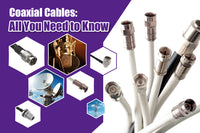In the world of electrical and low-voltage projects, there’s one crucial factor that can make or break your success - the wire gauge. If you’re into DIY patch cables, you’ll find that wires are whether too thin or thick, making termination a real challenge. Choosing the correct wire gauge size is a simple aspect but plays a vital role in the performance and efficiency of electrical installations. This article delves into everything about wire gauge and AWG.
What is Wire Gauge? What Does AWG Mean?
The wire gauge, indicating a wire’s thickness, is commonly measured using the American Wire Gauge. AWG, also known as Brown & Sharpe wire gauge, is a standard wire gauge system used in North America. It measures the diameter of various wires, including solid, stranded, round, and flat cables. While AWG can specify the size of both solid and stranded wires, stranded wires come with slightly different specifications and can be more complex. Stranded cables typically consist of multiple wires rather than just a solid wire. For example, “22 AWG (7/30)” denotes a 22 AWG stranded wire with 7 strands, each 30 AWG.
It’s important to note that the smaller the AWG number, the thicker the wire - a 23 AWG copper wire is thicker than a 24 AWG copper wire.
Common Wire Gauge Chart
Here we list some common wire gauge information for your reference:

Common Ethernet Cable Gauge
Some customers inquire about the compatibility of our RJ45 connectors or keystone jacks with Ethernet cables, as the Ethernet cable gauge matters in cable termination.

Ethernet cables come in different categories like Cat5e, Cat6, Cat6a, and Cat8, vary in wire gauges. These cables are the most prevalent Ethernet cables for home networks or data centers, and do you know their AWG? Typically, Cat5e cables use 24-26 AWG copper wire, Cat6 and Cat6a cables use 23 AWG conductors, but Cat6a cables can be a bit thicker than Cat6 cables due to shielding. Cat8 cables use 22-24 AWG conductors.
It’s worth noting that there isn’t a standardized Ethernet cable gauge. If you’re uncertain about the gauge of your Ethernet cable, we recommend reaching out to the manufacturer for accurate information.
How Does AWG Affect Cable Performance?
Don’t understate the power of cable AWG. It can significantly influence cable performance in various ways.
Signal Quality
Signal quality is vital for effective data transmission, especially in high-density network environments. Thicker wires, indicated by a smaller AWG, generally have lower electrical resistance, meaning that they can carry signals with less signal loss. The low resistance can ensure the efficiency of power transmission and signal integrity. So thicker wires can effectively keep high data transmission over a long distance. If you’re planning a network installation covering a long distance, opting for thicker wires is more suitable than thinner ones.
Heat Generation
Heat generation can affect the insulation and longevity of the cable, which is crucial for stable signal transmission. While the heat generation differences between thinner wires and thicker wires are minimal over short distances, thicker wires excel in handling overheating over longer distances because of their high current-carrying capacity. It is worth noting that thinner wires are generally better for airflow because there is enough room for air between wires. However, for network closets and dense installation environments, thicker wires remian the preferred choice.
Flexibility
Thinner wires are known for their enhanced flexibility compared to thicker counterparts, making them preferable for applications requiring frequent bending and installations in tight spaces.
PoE Applications
PoE technology allows the Ethernet cables to transmit power and data simultaneously, making your daily life very convenient. Thicker conductors are more suitable for PoE applications because they can handle higher power, and they are often used in various PoE applications, such as IP cameras, wireless access points, and VoIP phones.
Cost and Installation
The cost of wires takes up a great portion at a project expense. Thicker conductors generally cost more for their raw materials and thinner conductors can be more cost-effective for some specific applications.
22 AWG vs 24 AWG vs 26 AWG vs 28 AWG
We have mentioned that Ethernet cables come in various wire gauges, and the most common wire gauges range from 22 AWG to 28 AWG. Do you know the differences between these wire gauges and how to identify them?
22 AWG is a thick wire gauge that can carry high currents, so these wires are often used in long-distance applications. CAT8 cable generally uses 22 AWG for high-speed network transmission.
24 AWG wires are often found on solid cables and this wire gauge is also suitable for long distance. Cat5e and Cat6 cables often use 23 AWG or 24 AWG conductors. Please note that the maximum running length of Cat5e and Cat6 cables is 328 feet (100 meters).
26 AWG is a thin wire gauge often found on stranded cables, which is a great choice for short cable running. 28 AWG may be the most flexible wire gauge often used in short cable runs. 26 AWG and 28 AWG are popular wire gauges for Ethernet patch cables and they are favored by many users.
Final Thoughts
Selecting between larger and smaller wire gauges isn’t a one-size-fits-all decision for network installation. Whether to choose thick wires or thin wires depends on your specific needs. If you’re searching for an Ethernet cable for long-distance network installation, thicker wires are your prior option. In contrast, thinner wires may suffice for a copper patch cable connecting your computer and router. Before purchasing, evaluate factors such as running length, flexibility, transmission speed, and power requirements for better cable performance.
For more information on this topic, you can keep up on our blogs. While VCELINK offers general and basic information for our customers and other visitors to the website, it’s not professional advice.



Be the first one to comment.
Leave a comment